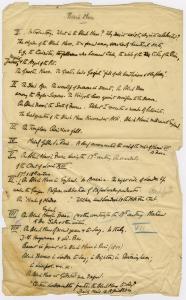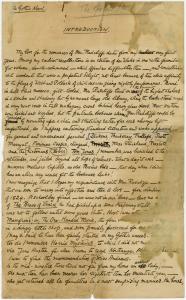Lost for more than 60 years, the Montague Summers Papers are exhibited here for the first time. Bringing Author Montague Summers into Focus hopes to shed light on the work and complicated personality of this little understood figure through a selection of his books and papers. It takes as a guide a few contemporary witnesses: Silhouette, a celebrity profile of Summers from 1945 in his local newspaper; a letter from Summers to an American fan, written mid-career in 1931; and, kept by the same fan, Summers’ 1948 obituary in the Associated Press – and a few others along the way.
Silhouette, Dr. M. Summers, M.A., F.R.S.L.
Wrenne Jarman
Richmond and Twickenham Times, November 24, 1945
From a series of profiles on neighborhood notables in Summers’ local newspaper, this column by the young poet Wrenne Jarman sums up the general public sense of Montague Summers near the end of his career.
Montague Summers to John Barker, Esq.
American book collector
August 27, 1931
Five years after publication of The History of Witchcraft and Demonology, this letter to a fan gives a convenient summation of Summers’ thesis and its growing alarmism– even expressing his regret for not having stated it clearly enough in his first book. Barker kept this letter in his copy of the 1st edition of Summers’ Malleus Maleficarum, along with Summers’ 1948 obituary from the Associated Press, and a clipped picture of Summers.
Arthur Balfour to Montague Summers
1st Earl of Balfour, British politician and statesman
December 3, 1926
Rabbi Francis Lyon Cohen to Montague Summers
Chief Rabbi of the Great Synagogue, Sydney, Australia
February 26, 1927
Clearly an interested reader, Rabbi Francis Cohen had well digested The History of Witchcraft and Demonology in far Sydney only months after its publication. In his letter he politely questions Summers’ support of the demonologists that he quotes, particularly their antisemitism.
The History of Witchcraft and Demonology
Montague Summers
London: Kegan, Paul, Trench, Trubner & Co., 1926
BF1566 .S86 1926
Summers’ first book on the subject set the example for what was to come: an exhaustive recounting of historical and literary cases, fully sourced in fine print in lengthy chapter notes– all tied together by the author’s alarmist theory of the reality of witchcraft and his antiquated and evocative language.
The Geography of Witchcraft
Montague Summers
London: Kegan, Paul, Trench, Trubner & Co., 1927
Published soon after The History of Witchcraft & Demonology, Summers’ second study continued pouring out his years of research, this time by country or region. Frequently referencing the most notorious and rare of the demonologists' and witch prosecutors' books, he would soon turn to providing these in English translation.
Letter from Vivian E. Hosking to Montague Summers
Reader on witchcraft and diabolism
May 19, 1927
Countess K. Vanden Heuvel to Montague Summers
Translator of Italian Paintings in America
August 18, 1927
Prompted by the Countess’ sympathetic reading of The Geography of Witchcraft, her letter gives an amusing account of her sister’s visit to a fortune teller’s shop in Wales, containing a number of tropes of the “diabolic witch cult”, including a mad old woman, a sinister old man, and a trip to a basement shrine with a horned altar.
Prospectus for Discours des Sorciers [ca. 1590]
John Rodker, Publisher, 1928
[Item on loan from private collection]
Discours des Sorciers would follow on the success of the Malleus Maleficarum with the title in English as An Examen of Witches. The projected titles for “The Church and Witchcraft” series are listed on the back of the prospectus, including two that were not ultimately published, by Peter Binsfield and Jean Wier (Johann Weyer).
Malleus Maleficarum [1486]
Heinrich Kramer and Jacob Springer
Translated and edited by Montague Summers
London: John Rodker, 1928
Folios ; BF1569.A2 I5 1928
The first volume of John Rodker’s “The Church and Witchcraft” series, and the first English translation of the infamous Hammer of Witches. Summers included the papal bull Summis desiderantes affectibus of Pope Innocent VIII, which was published in 1484 at the request of Heinrich Kramer to alert Europe to the threatening presence of a diabolic witch-cult and empower his inquisitorial activity in Germany. This was the only translation of the Malleus available for 80 years, and continues to be reprinted.
An Examen of Witches [1603]
Henry Boguet
Edited and introduced by Rev. Montague Summers, translated by E. Allen Ashwin
London: John Rodker, 1929
BF1582.A2 B63 1929
Compendium Maleficarum [1608]
Francesco Maria Guazzo
Edited and introduced by Rev. Montague Summers, translated by E. Allen Ashwin
London: John Rodker, 1929
Demonolatry [1595]
Nicholas Remy
Edited and introduced by Rev. Montague Summers, translated by E. Allen Ashwin
London: John Rodker, 1930
BF1520 .R45 1930
The Discoverie of Witchcraft [1584]
Reginald Scot
Edited and introduced by Rev. Montague Summers
London: John Rodker, 1930
BF1565 .S4 1930
Not published as part of the Church and Witchcraft series, Reginald Scot’s book would serve as a stand-in for the abandoned volume by Jean Wier (Johann Weyer). Both men were skeptical of witchcraft accusations and questioned the justice of the witch trials.
Frank Groves to Montague Summers
Operator of Librairie du Palais-Royal, bookshop and publisher in Paris
June 30, 1931
A letter which must have thrilled Summers, the Librairie du Palais-Royal was a Paris bookshop that published the first English translations of the work of Joris-Karl Huysmans, author of La-Bas, the 1891 French novel that addressed the subject of Satanism in contemporary France. Huysmans gave the most detailed description of the Black Mass published until then, although it is more literary invention than historical truth.
Letter from James Taylor Dunn to Montague Summers
Assistant Editor, Globe International Magazine
October 7, 1937
Letter from William Stallybrass to Montague Summers
Editor for Kegan Paul, Trench, Trubner, & Co.
February 17, 1928
The Vampire: His Kith & Kin
Montague Summers
London: Kegan, Paul, Trench, Trubner & Co., 1929
John Coghlan to Montague Summers
Devotee
January 18, 1935
This fan from Dublin praises Summers’ History of Witchcraft and Demonology and gushes over The Werewolf, asking if there are any more like it. Clearly having fallen under Montague’s spell, he was, presumably, satisfied with the response.
Les Véritables et les Fausses Messes Noires
S. Caleb
Paris: De Porter, circa 1920
Preserved in his papers, this cover illustration was likely collected by Summers to serve as an illustration for his projected work The Black Mass.
Witchcraft & Black Magic
Montague Summers
London: Rider & Co., 1946
The last of Summers’ original works on witchcraft to be published in his lifetime, Witchcraft & Black Magic was printed according to authorized economy standards put in place in the aftermath of World War II; this put the volume within reach of a wider audience who had found the price of earlier works to be an obstacle.
Letter from Nathan Mounse to Montague Summers
Jerusalem, Palestine
June 11, 1947
Another enthusiastic reader, this time from Jerusalem, Mr. Mounse has taken Summers’s text for an advertisement. In this instance, we see Summers’s drafted reply in the margins.
Letter from Lionel Downing to Montague Summers
Vice-Consul of the Netherlands, Cardiff
July 9, 1946
Pandaemonium [1684]
Richard Bovet: Edited and introduced by Montague Summers
Kent, UK: Hand & Flower Press, 1951
[Item on loan from private collection]
A Great Mistress of Romance: Ann Radcliffe, 1764-1823
Lecture given by Montague Summers
Transactions of the Royal Society of Literature of the United Kingdom, Second Series, Volume XXXV, 1917
Summers’ copy of a lecture given by him in January, 1917.
Draft pages from a proposed history of the Gothic novel by Summers
Early draft pages from Summers' long project of writing the history of the Gothic novel.
Letter from Michael Sadleir to Montague Summers
Book collector, bibliographer, literary historian
July 5, 1926
By the time of this letter’s writing, both Sadleir and Summers were deeply engaged in the search for surviving examples of the “Northanger Novels”, the existence of which would be revealed to readers the following year with Summers’s publishing of The Horrid Mysteries by Carl Grosse.
























































